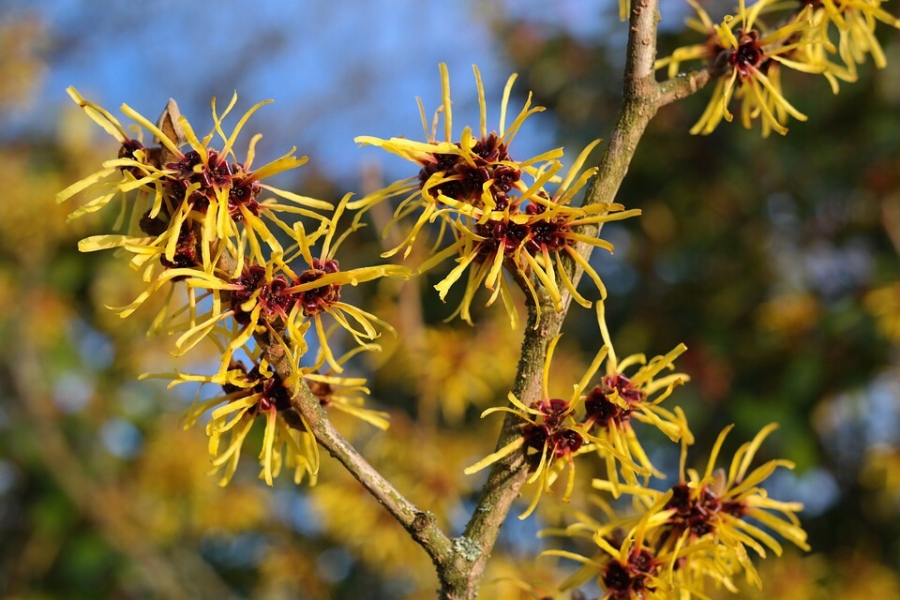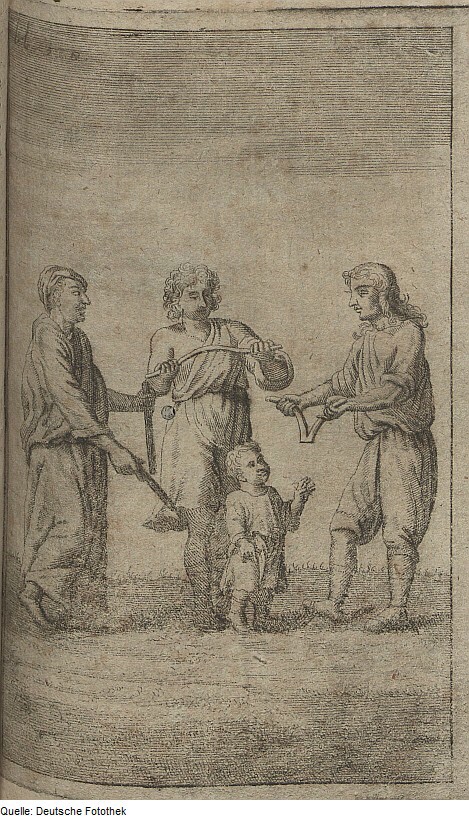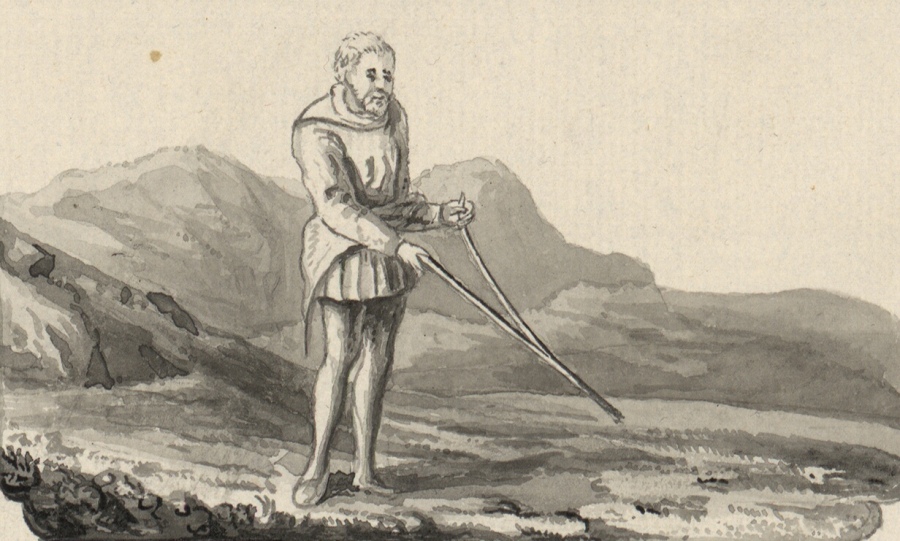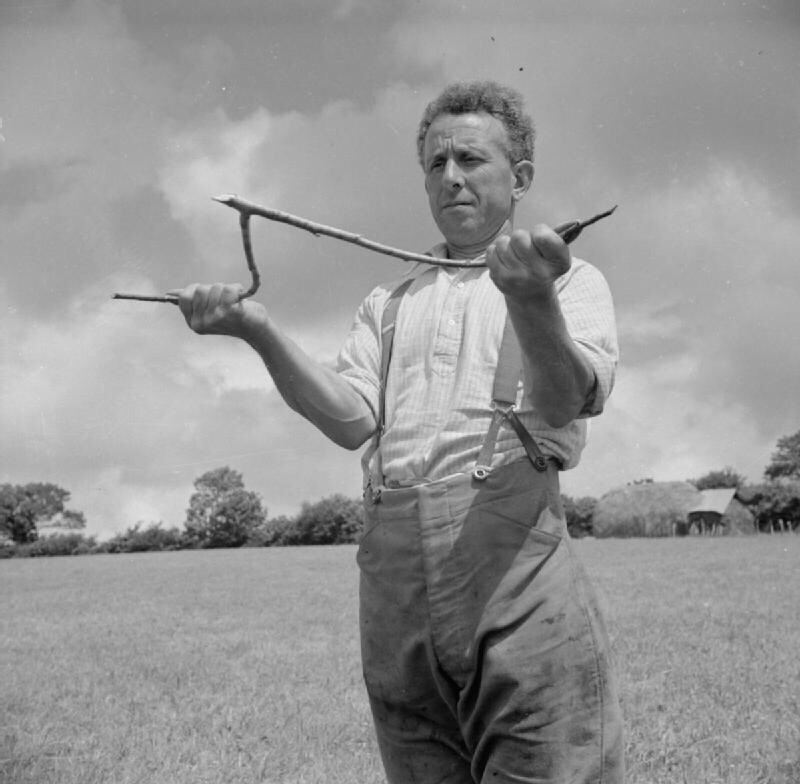I have always assumed that Witch Hazel (Hamamelis) earned its name because of its remarkable healing properties and its use by the wise-women of the Middle Ages – it appears I couldn’t have been more wrong….
Four native species of Witch Hazel are to be found in North America: Hamamelis mexicana, H. virginiana, H. vernalis and H. ovalis; another is to be found in China, H. mollis and a further one in Japan, H. japonica….. It was the Native American Indian people who taught early settlers how to use the twigs of Witch Hazel as divining rods, providing an alternative to the Hazel and Wych Elm they were more familiar with back in the UK and Europe…. The name Witch Hazel derives from that connection; ‘wych’, an old Anglo Saxon word, meaning ‘to bend’ – and also from the Middle English word ‘wiche’ (that in turn coming from the Old English ‘wice’) – both meaning ‘bendable’ or ‘pliable’….

Divining or dowsing (water witching in the US) is a way of detecting underground water…. However, dowsing is not just restricted to locating water; it can be used to search for metal ores, oil, gemstones….ley lines, archaeological remains – even missing persons….pretty much anything with an ‘energy’ source. Sometimes it is also used to diagnose certain medical ailments; (this is permitted in the UK and Europe – but not in the United States)….
Dowsing, in one form or another, has been used for thousands of years – from time before written history. Perhaps the oldest reference to it discovered so far is from a cave drawing found in Tassili, Algeria – which is over 8,000 years old. The oldest known written record comes from China, 2205 BC….
Even the Christian Bible could be said to have interpretations: Moses striking the rock and releasing water (Exodus 17) or the Magi could be argued to have practised a form by their use of astrology as an aid to navigation…. Ironically, it is the Christian Church that in Medieval times declared dowsing as breaking the 1st Commandment ~ “I am the Lord thy God, thou shalt not have any strange gods afore Me”…. The Church believed dowsing was practising superstition, one of the deadly sins….it became associated with the Devil – his powers believed to control the divining rods….

Certainly we know dowsing was used by the Ancient Egyptians and Chinese…. Possibly the original purpose was for predicting the future or determining if an accused person was guilty of a crime…. However, dowsing as we know it today seems to have originated in Germany, particularly in the Harz mountain area (incidentally thought of as a stronghold of Paganism), where it was used to locate metal ores underground for the mining industry…. Coins discovered in the region, dating to the 10th Century, appear to have been produced to celebrate the founding of a silver mine – the image depicted upon them being that of a dowser – proving the skill to have been very valuable in Germany at the time…. It was during the 15th Century that dowsing was introduced to the UK – when it came with German miners coming to work in British mines….

In 1518 Martin Luther, a German professor, priest, composer and key figure in the Protestant reformation in the 1500s, condemned dowsing as witchcraft- it was he who claimed it broke the 1st Commandment….

Strangely, only twelve years after Luther’s condemnation, Georg Bauer, a German physician and mining expert, wrote a paper and it was to become one of the most important works on the subject of mining (and the use of dowsing was included within it) of the time…. Nobody condemned him….raising the question as to whether the Medieval Church had more of a problem with authority rather than the actual act of divining itself….
In 1659 Jesuit Gaspar Schott, a German scientist specialising in physics, mathematics and natural philosophy – and one of the most learned and knowledgeable men of his time – declared dowsing as satanic….
Despite opposition from the Church dowsing was still used up to the 19th Century as a way of finding metal, coal and water…. It was Victorian scientists who claimed it was an invalid method – and having no place in a world where science was coming along in leaps and bounds….
However, even in these present days of scientific knowledge – where dowsing is still treated with skepticism – there are a surprising number of professionals who use the method; surveyors, architects, engineers….to name just a few….

It is thought just about anyone can dowse…. May be it is a natural instinct we have inherited from our ancient ancestors – after all animals can detect water from miles away, so once upon a time, did we possess a natural ability to do the same? Children especially are thought to have a natural flair….

Traditionally – as mentioned before – Hazel or Wych Elm are the preferred choice of divining rod…. Elm and Hazel – along with Ash, Rowan and Willow – are thought to have magical powers…. Nowadays metals are often used, such as copper or aluminium – even wire coat hangers bent to shape have been proven to work…. (Occasionally a dowser may choose to work with a pendulum rather than rods)…. The idea is, when the rods are held in the correct way and the dowser moves slowly around the area he is searching if the source is found the tips of the rods may twitch, point down or cross over….
Of course there are the skeptics among us who will say it is because the dowser is so mentally in-tune with what they are looking for that they will involuntarily move the rods themselves…. Or perhaps the energy from the source stimulates the muscles in the nervous system – some sort of electro-magnetic impulse…. There are others who just ‘poo-poo’ the whole idea….
If you do happen to witness a dowser at work it can be quite an incredible thing to see….
Personally, I am very open-minded about the subject, being fortunate enough to have had some first-hand experience. It was during the early stages of the restoration work we undertook on the cottage….we were in the process of trying to work out where the underground LPG tank should be buried in the front garden – realising that one part of the garden seemed prone to ‘sinking’…. Being in direct line with the back door, one thought was that perhaps it was the site of a disused well…. A digger-driver friend, with us at the time to help with the groundworks, suddenly surprised us by whipping out a pair of divining rods…. He then proceeded to slowly cover the area, holding the rods out in front of him….and sure enough when he came to the sunken part the rods sprang to life…. We were amazed…. Unable to resist having a go myself, Colin showed me how to hold the rods correctly and I had a try….and no word of a lie – it worked! The rods, completely independently, dipped down and crossed at the tips – as if they had a mind of their own….
Sadly, even after digging quite a way down, no water was to be found at that particular spot…. Nowadays a flower bed lies there, although nothing really successfully grows in it as the ground continues to sink away – countless barrows of soil have been used over the years to top it up – so we are not entirely convinced there is nothing there to be found….We are planning to redesign that part of the garden this coming Spring – perhaps a little more investigation work is required….







